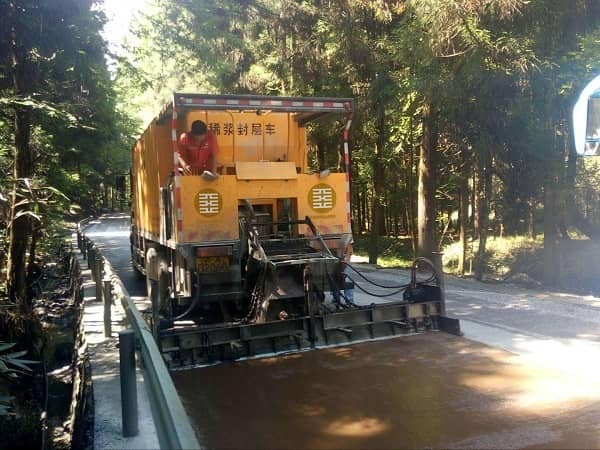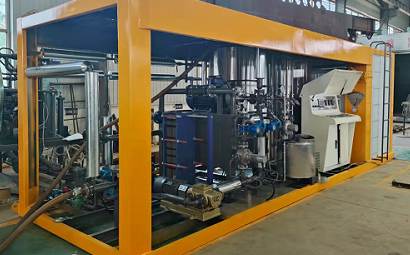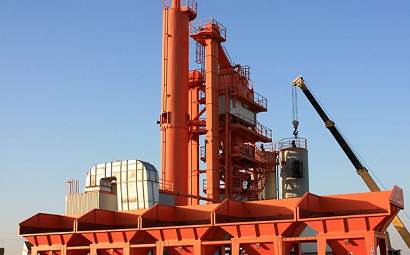Slurry sealing originated in Germany and has a history of more than 90 years. Slurry seals have a wide range of applications and can also be used for highway maintenance. Because it has the advantages of saving energy, reducing environmental pollution and extending the construction season, it is increasingly favored by highway technicians and maintenance workers. Slurry sealing layer is made of appropriately graded stone chips or sand, fillers (cement, lime, fly ash, stone powder, etc.), emulsified asphalt, external admixtures and water, which are mixed into a slurry in a certain proportion and spread A pavement structure that functions as a seal after being paved, hardened, and formed. Because the consistency of this slurry mixture is thin and the shape is like slurry, the paving thickness is generally between 3-10mm, and it mainly plays the role of waterproofing or improving and restoring the pavement function. With the rapid development of polymer-modified emulsified asphalt and the improvement of construction technology, polymer-modified emulsified asphalt slurry seal has appeared.


The slurry seal has the following functions:
1. Waterproofing
The aggregate particle size of the slurry mixture is relatively fine and has a certain gradation. The emulsified asphalt slurry mixture is formed after the pavement is paved. It can adhere firmly to the road surface to form a dense surface layer, which can prevent rain and snow from penetrating into the base layer and maintain the stability of the base layer and soil base:
2. Anti-slip effect
Since the paving thickness of the emulsified asphalt slurry mixture is thin, and the coarse materials in its gradation are evenly distributed, and the amount of asphalt is appropriate, the phenomenon of oil flooding on the road will not occur. The road surface has a good rough surface. The friction coefficient is significantly increased, and the anti-skid performance is significantly improved.
3. Wear resistance
Cationic emulsified asphalt has good adhesion to both acidic and alkaline mineral materials. Therefore, the slurry mixture can be made of high-quality mineral materials that are hard to wear and grind, so it can obtain good wear resistance and extend the service life of the road surface.
4. filling effect
The emulsified asphalt slurry mixture contains a lot of water, and after mixing, it is in a slurry state and has good fluidity. This slurry has a filling and leveling effect. It can stop small cracks in the road surface and uneven pavement caused by looseness and falling off of the road surface. The slurry can be used to seal cracks and fill shallow pits to improve the smoothness of the road surface.
Advantages of slurry seal:
1. It has better wear resistance, waterproof performance, and stronger adhesion to the underlying layer;
2. It can extend the life of roads and reduce comprehensive maintenance costs;
3. The construction speed is faster and has less impact on traffic;
4. Work at normal temperature, clean and environmentally friendly.
Key technologies for slurry sealing construction:
1. The materials meet the technical requirements. The aggregate is hard, the gradation is reasonable, the emulsifier type is appropriate, and the slurry consistency is moderate.
2. The sealing machine has advanced equipment and stable performance.
3. The old road requires that the overall strength of the old road meets the requirements. The areas with insufficient strength must be reinforced. The pits and serious cracks must be dug and repaired. The bales and washboards must be milled. Cracks larger than 3 mm must be filled in advance. Roads must be cleared.
4. Traffic management. Strictly cut off traffic to prevent vehicles from driving on the slurry seal before it solidifies.
 Albanian
Albanian  Russian
Russian  Arabic
Arabic  Amharic
Amharic  Azerbaijani
Azerbaijani  Irish
Irish  Estonian
Estonian  Odia (Oriya)
Odia (Oriya)  Basque
Basque  Belarusian
Belarusian  Bulgarian
Bulgarian  Icelandic
Icelandic  Polish
Polish  Bosnian
Bosnian  Persian
Persian  Afrikaans
Afrikaans  Tatar
Tatar  Danish
Danish  German
German  French
French  Filipino
Filipino  Finnish
Finnish  Frisian
Frisian  Khmer
Khmer  Georgian
Georgian  Gujarati
Gujarati  Kazakh
Kazakh  Haitian Creole
Haitian Creole  Korean
Korean  Hausa
Hausa  Dutch
Dutch  Kyrgyz
Kyrgyz  Galician
Galician  Catalan
Catalan  Czech
Czech  Kannada
Kannada  Corsican
Corsican  Croatian
Croatian  Kurdish (Kurmanji)
Kurdish (Kurmanji)  Latin
Latin  Latvian
Latvian  Lao
Lao  Lithuanian
Lithuanian  Luxembourgish
Luxembourgish  Kinyarwanda
Kinyarwanda  Romanian
Romanian  Malagasy
Malagasy  Maltese
Maltese  Marathi
Marathi  Malayalam
Malayalam  Malay
Malay  Macedonian
Macedonian  Maori
Maori  Mongolian
Mongolian  Bengali
Bengali  Myanmar (Burmese)
Myanmar (Burmese)  Hmong
Hmong  Xhosa
Xhosa  Zulu
Zulu  Nepali
Nepali  Norwegian
Norwegian  Punjabi
Punjabi  Portuguese
Portuguese  Pashto
Pashto  Chichewa
Chichewa  Japanese
Japanese  Swedish
Swedish  Samoan
Samoan  Serbian
Serbian  Sesotho
Sesotho  Sinhala
Sinhala  Esperanto
Esperanto  Slovak
Slovak  Slovenian
Slovenian  Swahili
Swahili  Scots Gaelic
Scots Gaelic  Cebuano
Cebuano  Somali
Somali  Tajik
Tajik  Telugu
Telugu  Tamil
Tamil  Thai
Thai  Turkish
Turkish  Turkmen
Turkmen  Welsh
Welsh  Uyghur
Uyghur  Urdu
Urdu  Ukrainian
Ukrainian  Uzbek
Uzbek  Spanish
Spanish  Hebrew
Hebrew  Greek
Greek  Hawaiian
Hawaiian  Sindhi
Sindhi  Hungarian
Hungarian  Shona
Shona  Armenian
Armenian  Igbo
Igbo  Italian
Italian  Yiddish
Yiddish  Hindi
Hindi  Sundanese
Sundanese  Indonesian
Indonesian  Javanese
Javanese  Yoruba
Yoruba  Vietnamese
Vietnamese  Hebrew
Hebrew  Chinese (Simplified)
Chinese (Simplified)







